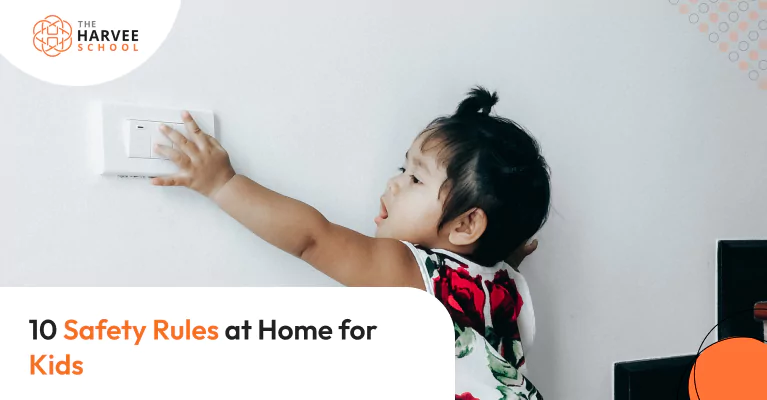10 Safety Rules at Home for Kids
Kids grow quickly and we realise it when they end up causing a lot of trouble. Ensuring their safety at home is a top priority for parents and caregivers. While home is often considered the safest place, it’s essential to establish safety guidelines to prevent accidents. Here are ten crucial safety rules at home for kids that every parent should implement.
1. Never Play with Fire or Sharp Objects
Teach your children to stay away from matches, lighters, candles, and sharp objects like knives or scissors. Explain the dangers of fire and injuries caused by sharp tools. Store these items in locked drawers or cabinets, out of children’s reach. Demonstrate how to handle these items during supervised activities so that kids can understand the risk.
2. Do Not Open the Door for Strangers
Kids should never open the door to strangers, even if the person claims to know the family. Teach them to call an adult immediately if someone unfamiliar is at the door. Installing a peephole or security camera can help reinforce this rule. Additionally, practice role-playing scenarios with your child so they feel confident handling such situations.
3. Stay Away from Electrical Outlets and Appliances
Electricity is a major hazard for kids. Use safety covers for electrical outlets and keep cords and appliances out of reach. Teach your children to never insert objects into outlets or operate appliances without supervision. Regularly check for frayed cords or malfunctioning devices, and replace them immediately to avoid accidents.
4. Always Ask Before Using Medicine
Medications should be treated with caution. Store all medicines in a secure place, and teach your kids to never consume anything without asking an adult. Explain that medicine is not candy and can be harmful if misused. It’s helpful to educate them about the purpose of medicines and the importance of following prescribed dosages.
5. Avoid Running on Slippery Floors
Slippery floors are a common cause of falls. Encourage kids to walk instead of running, especially in areas like the kitchen or bathroom. Use non-slip mats and clean up spills immediately to prevent accidents. Make it a habit to keep clutter off the floors to reduce the chances of tripping.
6. Stay Away from the Kitchen During Cooking
The kitchen is full of potential hazards, including hot surfaces, boiling liquids, and sharp tools. Set a rule that children should stay out of the kitchen when cooking is in progress unless supervised. Consider creating a designated safe zone in the kitchen where kids can observe without being in harm’s way.
7. Do Not Climb on Furniture
Climbing on furniture like chairs, tables, or shelves can lead to falls or even tipping over heavy items. Secure heavy furniture to the wall and discourage kids from climbing by providing safe play areas. Teaching them the appropriate use of furniture is essential in minimizing risks.
8. Know Emergency Contact Numbers
Teach your children how to call emergency services in case of an accident. Make sure they know their full name, address, and at least one parent’s phone number. Keep a list of emergency numbers in an easily accessible place. Practicing mock emergency drills can help them remember these details better.
9. Keep Small Objects Out of Reach
Small objects like coins, buttons, or beads can pose a choking hazard. Ensure such items are kept out of reach and supervise playtime, especially with toys containing small parts. Regularly inspect toys and household items to ensure they’re safe for your child’s age and developmental stage.
10. Beware of Pets
Even the friendliest pets can become unpredictable. Teach kids to always ask an adult before touching or playing with a pet. They should also learn to recognize signs of discomfort or aggression in animals. Supervising interactions with pets can help prevent bites or scratches.
Additional Tips for Parents
Childproof Your Home: Install safety gates, cabinet locks, and corner guards to minimize risks. Check regularly for potential hazards like loose wires or unstable furniture.
Teach Through Role-Playing: Simulate situations like a stranger at the door or an emergency to reinforce safety rules. This hands-on approach helps children internalize the lessons more effectively.
Be a Role Model: Follow the rules yourself to set a good example for your children. Consistency in enforcing these rules ensures they become habits over time.
Supervise Regularly: Even with all precautions in place, supervision is key to ensuring children’s safety. Stay attentive and involved in their daily activities.
By following these safety rules, parents can create a secure environment where children can grow and explore without unnecessary risks. Always remember that constant supervision and communication are key to ensuring your child’s safety at home. Encourage open discussions about safety, so kids feel comfortable seeking guidance when needed.






